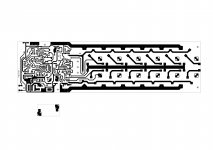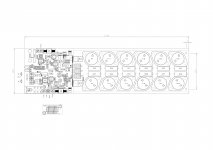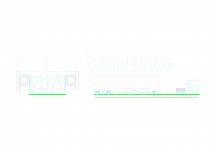Thanks Kay and Fahey. I never got a manual for my 234. I Used information from Rane web site which is very thorough, bys still got hiss af hum. I will check my homesolered cables again. Cheers!
FWIW the manual at Rane site is: https://dbxpro.com/en/product_documents/dbx223234xlmanuala2pdf--4
Hiss does not depend on cable shielding so it´s either on music program or music source or *maybe* your crossover was set to too high gain.
Hum/buzz can come even with perfect shielding if you have a grounding problem, in your sound_source>crossover>power_amp setup.
Hiss does not depend on cable shielding so it´s either on music program or music source or *maybe* your crossover was set to too high gain.
Hum/buzz can come even with perfect shielding if you have a grounding problem, in your sound_source>crossover>power_amp setup.
Thanks again Fahey. Actually there is a little mechanical ”hum” from the crossover itself. When time permits I will change ps. I just had a suspision that my atempt of ”semibalanced” conections was part of the problem. We will see🙂
PA_300/400
Hello, Kay.
Sorry, I was away. I'm not back home yet. Ok I would give the Pcb of 300,400,600. It is still in verification, because we have created a routing conforming to our case, visible on the attachments.
Best regards.
Hello, Kay.
Sorry, I was away. I'm not back home yet. Ok I would give the Pcb of 300,400,600. It is still in verification, because we have created a routing conforming to our case, visible on the attachments.
Best regards.
PA_300/400
For the C9 capacity it is the compensation, at least we say so in French. Be careful, she plays on the slew-rate. Everything is indicated on the AOP 55.xxx datasheet. Normally it's more like 22 pF. The more the capacity decreases, the more the slew-rate increases. From memory it is 13v / µs maximum. Why Elektor put 33 pF, mystery. But it works. Mandatory to connect a 33 pF on pins N ° 6 & N ° 2, otherwise guaranteed oscillations.
Protection is not a problem, at least not on our side. Attention, it is preferable to mount the power supply as the original diagram. If unable to correct, the NE55.xxx is a copy. Take a circuit of big brand and not of Chinese origin !!!!.
We installed a Pa version 400, apart from a Pcb error corrected by bridging, it works well. The routing of our version took time, the Pcb is not yet fixed.
We are also testing a version with 78 / 79.xx regulators. Better in terms of stability and noise. Advice from an engineer who is a size in France.
Greetings, Jacky
For the C9 capacity it is the compensation, at least we say so in French. Be careful, she plays on the slew-rate. Everything is indicated on the AOP 55.xxx datasheet. Normally it's more like 22 pF. The more the capacity decreases, the more the slew-rate increases. From memory it is 13v / µs maximum. Why Elektor put 33 pF, mystery. But it works. Mandatory to connect a 33 pF on pins N ° 6 & N ° 2, otherwise guaranteed oscillations.
Protection is not a problem, at least not on our side. Attention, it is preferable to mount the power supply as the original diagram. If unable to correct, the NE55.xxx is a copy. Take a circuit of big brand and not of Chinese origin !!!!.
We installed a Pa version 400, apart from a Pcb error corrected by bridging, it works well. The routing of our version took time, the Pcb is not yet fixed.
We are also testing a version with 78 / 79.xx regulators. Better in terms of stability and noise. Advice from an engineer who is a size in France.
Greetings, Jacky
Thank you, Jacky!
Is it correct that two separate L brackets and heatsinks are necessary per board?
Best regards!
Is it correct that two separate L brackets and heatsinks are necessary per board?
Best regards!
PA_300/400
Hi, Kay.
It should be understood that two L-shaped angles of 40x40_Ep = 5 mm is less expensive than a U of 80x40.
It is easier to machine the angle iron than the U. In addition, it is not too standardized, among manufacturers. But you can do it at a factory.
Then the, L must be connected to the main heatsink. Or do a tunnel assembly. 8 pairs at 100 volts this starts to make a nice heater. Then it is a question of feeling and of handyman ability. We are fine with the approach used on the top view of the amplifier that I have detailed. And if assembly in bridge then, it is obligatory tunnel. I hope to have answered.
Greetings.
Jacky
Hi, Kay.
It should be understood that two L-shaped angles of 40x40_Ep = 5 mm is less expensive than a U of 80x40.
It is easier to machine the angle iron than the U. In addition, it is not too standardized, among manufacturers. But you can do it at a factory.
Then the, L must be connected to the main heatsink. Or do a tunnel assembly. 8 pairs at 100 volts this starts to make a nice heater. Then it is a question of feeling and of handyman ability. We are fine with the approach used on the top view of the amplifier that I have detailed. And if assembly in bridge then, it is obligatory tunnel. I hope to have answered.
Greetings.
Jacky
Attachments
Wont reused PC coolers for highpowered cpu be efficient? Just one for each output transistor. Mounted to alow vertical airflow.
Cheers!
Cheers!
Don´t think transistor per transistor but the big overheated block you are trying to cool.
As in: 1 or 2 (depending on layout) large "tunnels" where you concentrate large airflow and lots of fins together.
A CPU is on its own, or maybe you have two in a PC case, not 8/12/16/whatever transistors all together side by side.
And total heat generated is more than anything a CPU can generate.
As in: 1 or 2 (depending on layout) large "tunnels" where you concentrate large airflow and lots of fins together.
A CPU is on its own, or maybe you have two in a PC case, not 8/12/16/whatever transistors all together side by side.
And total heat generated is more than anything a CPU can generate.
Hi Jacky,
I'm not too sure that I get you right. Do you mean two L shaped brackets per board, which would mean two separate heatsinks, or two per side that are screwed together so that the board could be mounted in parallel with one single sink?
Best regards!
I'm not too sure that I get you right. Do you mean two L shaped brackets per board, which would mean two separate heatsinks, or two per side that are screwed together so that the board could be mounted in parallel with one single sink?
Best regards!
- Home
- More Vendors...
- Elektor
- Elektor PA300




